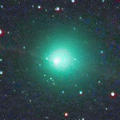
|
It brightened up to 7.9 mag in mid February (Feb. 21, Osamu Miyazaki). Now it is not observable. In the Southern Hemisphere, it will appear in the morning sky in late March at 8 mag, then it stays observable while the comet will be fading. In the Northern Hemisphere, it stays unobservable until May when it becomes fainter than 14 mag.
Date(TT) R.A. (2000) Decl. Delta r Elong. m1 Best Time(A, h)
Mar. 11 23 32.89 -4 22.3 0.658 0.337 2 6.1 19:49 ( 72,-16)
Mar. 18 22 54.94 -12 51.1 0.696 0.397 18 6.7 4:36 (286, 0)
|
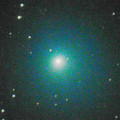
|
Now it is 9.2 mag (Mar. 6, Chris Wyatt). Brightening rapidly. It will approach to the earth down to 0.14 a.u. from March to April. It is expected to brighten up to 5-6 mag. It may brighten furthermore in outburst. It is observable in excellent condition in the Northern Hemisphere. In the Southern Hemisphere, it will not be observable for about one month from late March to late April.
Date(TT) R.A. (2000) Decl. Delta r Elong. m1 Best Time(A, h)
Mar. 11 10 5.17 39 38.6 0.178 1.135 139 7.8 22:50 (180, 15)
Mar. 18 10 36.90 49 15.7 0.158 1.102 129 6.8 22:56 (180, 5)
|
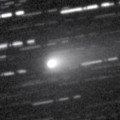
|
Now it is 10.0 mag (Mar. 6, Chris Wyatt). It is expected to brighten up to 7 mag from April to May. But recently it is fainter than predicted. It locates somewhat low at the high light.
Date(TT) R.A. (2000) Decl. Delta r Elong. m1 Best Time(A, h)
Mar. 11 18 48.37 -22 22.4 1.439 1.429 69 8.8 4:29 (265, 48)
Mar. 18 19 20.79 -20 57.9 1.355 1.357 68 8.5 4:36 (263, 48)
|
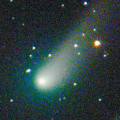
|
Now it is 9.8 mag (Mar. 9, Katsumi Yoshimoto). It is expected to brighten up to 6-7 mag from April to July. Recently it is fainter than predicted. In the Northern Hemisphere, it stays observable in good condition until the highlight while the comet will be brightening. In the Southern Hemisphere, it stays extremely low for a while.
Date(TT) R.A. (2000) Decl. Delta r Elong. m1 Best Time(A, h)
Mar. 11 16 26.14 46 43.3 1.584 2.047 102 8.8 4:29 (187, 8)
Mar. 18 16 30.29 47 6.9 1.502 1.995 104 8.6 4:36 (182, 8)
|
 TJL006
TJL006

|
New comet discovered by Terry Lovejoy on Mar. 9. Now it is bright as 11.8 mag (Mar. 10, Hidetaka Sato). In the Northern Hemisphere, it stays observable until late April while the comet will be brightening gradually. In the Southern Hemisphere, it becomes unobservable in early April.
Date(TT) R.A. (2000) Decl. Delta r Elong. m1 Best Time(A, h)
Mar. 11 18 57.78 -31 43.4 0.928 1.079 68 12.2 4:29 (280, 50)
Mar. 18 19 39.63 -22 45.6 0.762 0.958 64 11.2 4:36 (269, 45)
|
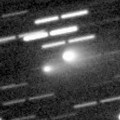
|
Now it is 12.2 mag (Mar. 6, Chris Wyatt). Bright new fragment BT was discovered on Feb. 10. Now the fragment BT is fainter than the primary component. It will be unobservable soon in the Northern Hemisphere. In the Southern Hemisphere, it stays observable for a long time after this.
Date(TT) R.A. (2000) Decl. Delta r Elong. m1 Best Time(A, h)
Mar. 11 20 36.10 -20 13.8 1.401 0.976 44 11.9 4:29 (278, 25)
Mar. 18 21 11.13 -19 5.3 1.426 0.972 42 12.0 4:36 (277, 24)
|
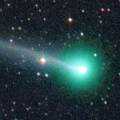
|
It approached to the earth down to 0.08 a.u. in mid February, and brightened up to 6.5 mag (Feb. 10, Danil Sidorko). Now it is fading rapidly. It has already faded down to 10.8 mag (Mar. 7, Osamu Miyazaki).
Date(TT) R.A. (2000) Decl. Delta r Elong. m1 Best Time(A, h)
Mar. 11 10 46.08 23 29.3 0.395 1.368 158 12.0 23:28 (180, 32)
Mar. 18 10 37.33 21 53.7 0.504 1.461 152 13.0 22:52 (180, 33)
|

|
It has not been observed yet in this apparition. The condition of this apparition is worst. It will brighten up to 10 mag in spring, but not observable at all.
Date(TT) R.A. (2000) Decl. Delta r Elong. m1 Best Time(A, h)
Mar. 11 23 32.65 2 28.3 2.182 1.201 6 12.9 19:49 ( 79,-20)
Mar. 18 23 58.44 4 27.1 2.146 1.161 5 12.6 19:38 ( 82,-20)
|
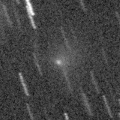
|
It brightened very rapidly. Now it is bright as 12.2 mag (Mar. 1, Gabor Santa). Small comet, but it approaches to the sun down to 0.9 a.u., and to the earth down to 0.5 a.u., and it will brighten up to 12.5 mag in March. It is observable in excellent condition in the Northern Hemisphere. In the Southern Hemisphere, it stays observable only until mid February. Juan Jose Gonzalez reported it is very bright as 10.7 mag on Feb. 24.
Date(TT) R.A. (2000) Decl. Delta r Elong. m1 Best Time(A, h)
Mar. 11 2 44.82 42 41.5 0.581 0.913 64 12.6 19:49 (138, -8)
Mar. 18 3 4.53 52 4.5 0.554 0.930 66 13.0 19:38 (146,-14)
|
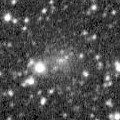
|
New bright comet. Now it is 12.2 mag (Mar. 3, Seiichi Yoshida). It stays 13 mag until May. In the Southern Hemisphere, it stays observable for a long time, but it stays low. It will not be observable in early April in the Northern Hemisphere.
Date(TT) R.A. (2000) Decl. Delta r Elong. m1 Best Time(A, h)
Mar. 11 19 59.68 -9 32.0 1.332 1.049 51 13.3 4:29 (263, 27)
Mar. 18 20 38.85 -8 26.9 1.322 0.993 48 13.1 4:36 (262, 25)
|
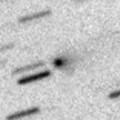
|
Now it is 16.4 mag (Mar. 8, Thomas Lehmann). It is expected to brighten up to 10 mag in summer. But actually, it is much fainter than this ephemeris recently. It will be observable in excellent condition in the Southern Hemisphere. It locates low in the Northern Hemisphere.
Date(TT) R.A. (2000) Decl. Delta r Elong. m1 Best Time(A, h)
Mar. 11 15 52.34 -13 2.6 1.288 1.892 111 14.0 4:29 (186, 68)
Mar. 18 16 2.07 -13 48.5 1.195 1.860 115 13.6 4:20 (180, 69)
|

|
Appearing in the morning sky. Now it is 15.3 mag (Mar. 5, CAO, San Pedro de Atacama).
Date(TT) R.A. (2000) Decl. Delta r Elong. m1 Best Time(A, h)
Mar. 11 21 5.81 -17 18.2 6.627 5.859 36 13.9 4:29 (279, 17)
Mar. 18 21 10.75 -16 52.6 6.555 5.858 42 13.8 4:36 (275, 23)
|
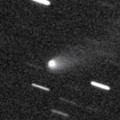
|
Now it is 14.6 mag (Feb. 28, Hiroshi Abe). It is observable in excellent condition in the Northern Hemisphere. It stays low in the Southern Hemisphere.
Date(TT) R.A. (2000) Decl. Delta r Elong. m1 Best Time(A, h)
Mar. 11 11 50.74 32 24.1 1.618 2.532 150 14.3 0:37 (180, 23)
Mar. 18 11 45.66 32 25.4 1.646 2.548 148 14.4 0:05 (180, 23)
|
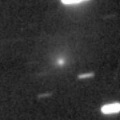
|
Now it is bright as 14.4 mag (Jan. 14, Thomas Lehmann). It will be observable at 11 mag for a long time from 2017 to 2018. It will be unobservable temporarily soon in the Northern Hemisphere, or in May in the Southern Hemisphere.
Date(TT) R.A. (2000) Decl. Delta r Elong. m1 Best Time(A, h)
Mar. 11 2 59.86 -23 25.5 5.425 4.930 55 14.6 19:49 ( 85, 36)
Mar. 18 3 3.89 -22 4.5 5.434 4.877 51 14.6 19:38 ( 85, 33)
|
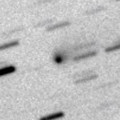
|
Now it is 15.4 mag (Feb. 25, T. Ikemura, H. Sato). It will brighten up to 14 mag from spring to summer. It locates somewhat low in the Northern Hemisphere. The perihelion distance increased from 2.4 a.u. to 2.9 a.u. in this apparition. So it will not be bright as before.
Date(TT) R.A. (2000) Decl. Delta r Elong. m1 Best Time(A, h)
Mar. 11 16 23.30 -19 10.5 2.724 3.105 103 14.9 4:29 (212, 72)
Mar. 18 16 26.88 -19 28.9 2.619 3.093 109 14.8 4:36 (188, 74)
|
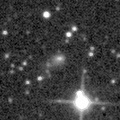
|
Now it is 16.7 mag (Nov. 3, Kunihiro Shima). It will be observable at 13 mag for a long time from 2017 to 2018. It is appearing in the morning sky again.
Date(TT) R.A. (2000) Decl. Delta r Elong. m1 Best Time(A, h)
Mar. 11 19 11.49 1 55.2 5.147 4.787 63 15.2 4:29 (244, 29)
Mar. 18 19 11.82 3 3.2 5.003 4.750 69 15.1 4:36 (236, 34)
|
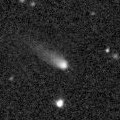
|
Now it is 15.6 mag (Feb. 15, Alexander Baransky). It will brighten up to 12-13 mag and will be observable in good condition in summer. Now it is not observable. It will appear in the morning sky in May.
Date(TT) R.A. (2000) Decl. Delta r Elong. m1 Best Time(A, h)
Mar. 11 0 11.57 13 18.7 4.146 3.236 20 15.2 19:49 ( 94,-19)
Mar. 18 0 13.11 13 22.8 4.147 3.199 15 15.1 19:38 ( 92,-22)
|

|
Now it is 14.3 mag (Dec. 31, Jakub Cerny). It will be unobservable soon.
Date(TT) R.A. (2000) Decl. Delta r Elong. m1 Best Time(A, h)
Mar. 11 1 31.32 -0 22.0 6.125 5.307 31 15.2 19:49 ( 94, 5)
Mar. 18 1 37.45 0 8.2 6.196 5.327 26 15.2 19:38 ( 92, 3)
|
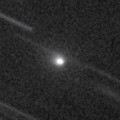
|
Now it is 15.0 mag (Feb. 25, Alexander Baransky). It stays 15 mag until spring. But it is already unobservable in the Southern Hemisphere. It will be getting lower gradually after this also in the Northern Hemisphere.
Date(TT) R.A. (2000) Decl. Delta r Elong. m1 Best Time(A, h)
Mar. 11 1 57.63 21 42.2 2.248 1.703 45 15.2 19:49 (115, -2)
Mar. 18 2 17.73 23 20.3 2.290 1.709 43 15.3 19:38 (117, -3)
|
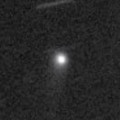
|
Now it is 15.3 mag (Dec. 29, Kunihiro Shima). Now it is not observable. In the Northern Hemisphere, it will appear in the morning sky in late April. Then it will brighten up to 14 mag from summer to next winter, and it will be observable in excellent condition. In the Southern Hemisphere, it will be observable in the very low sky only from May to June.
Date(TT) R.A. (2000) Decl. Delta r Elong. m1 Best Time(A, h)
Mar. 11 23 30.65 8 14.6 4.636 3.671 12 15.5 19:49 ( 83,-24)
Mar. 18 23 35.80 9 49.7 4.609 3.639 11 15.4 4:36 (273,-22)
|

|
It brightened up to 11 mag from spring to summer in 2016. It is appearing in the morning sky again. Now it is 16.5 mag (Mar. 4, T. Ikemura, H. Sato). It will be observable at 16-17 mag in good condition from spring to summer.
Date(TT) R.A. (2000) Decl. Delta r Elong. m1 Best Time(A, h)
Mar. 11 19 39.85 -19 34.9 3.029 2.623 56 15.8 4:29 (270, 36)
Mar. 18 19 49.20 -19 11.7 2.988 2.664 61 15.9 4:36 (266, 41)
|

|
Now it is 15.7 mag (Feb. 23, T. Ikemura, H. Sato). It stays 16-17 mag for a long time from 2016 to 2019. It stays near by the equator.
Date(TT) R.A. (2000) Decl. Delta r Elong. m1 Best Time(A, h)
Mar. 11 9 7.02 4 22.8 8.775 9.611 145 15.9 21:50 (180, 51)
Mar. 18 9 6.07 4 42.6 8.836 9.607 138 15.9 21:21 (180, 50)
|

|
It has not been observed yet in this apparition. It will brighten up to 12 mag in summer. It will be observable in excellent condition in the Southern Hemisphere. It locates somewhat low in the Northern Hemisphere.
Date(TT) R.A. (2000) Decl. Delta r Elong. m1 Best Time(A, h)
Mar. 11 18 1.07 -33 0.1 2.427 2.462 80 16.2 4:29 (276, 62)
Mar. 18 18 13.01 -33 9.4 2.316 2.435 84 15.9 4:36 (274, 66)
|

|
Now it is 16.3 mag (Feb. 25, Alexander Baransky). It stays observable at 16 mag until June. It locates low in the Southern Hemisphere.
Date(TT) R.A. (2000) Decl. Delta r Elong. m1 Best Time(A, h)
Mar. 11 6 44.25 27 40.9 3.255 3.705 109 15.9 19:49 (175, 27)
Mar. 18 6 46.25 27 36.8 3.347 3.698 102 16.0 19:38 (171, 27)
|
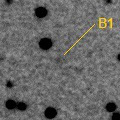
|
Now it is 17.3 mag (Mar. 3, T. Ikemura, H. Sato). It was observed at 16 mag from spring to summer in 2016. It will be observable at 16 mag also in 2017 from winter to spring.
Date(TT) R.A. (2000) Decl. Delta r Elong. m1 Best Time(A, h)
Mar. 11 18 6.17 -0 3.7 3.367 3.335 79 16.1 4:29 (231, 42)
Mar. 18 18 11.76 1 46.7 3.297 3.354 84 16.1 4:36 (222, 45)
|
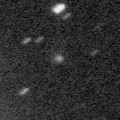
|
Now it is 17.0 mag (Mar. 2, Thomas Lehmann). It is expected to brighten up to 9 mag in summer in 2018. In the Northern Hemisphere, it stays observable until 2018 summer while the comet will be brightening. In the Southern Hemisphere, it is hardly observable in 2017, but it will be observable in good condition in 2018.
Date(TT) R.A. (2000) Decl. Delta r Elong. m1 Best Time(A, h)
Mar. 11 19 6.13 46 54.6 5.850 5.690 75 16.4 4:29 (212, -4)
Mar. 18 19 8.84 47 30.0 5.762 5.634 77 16.3 4:36 (207, -1)
|
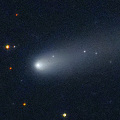
|
It brightened up to 11-12 mag from summer to autumn. Now it is fading. It has already faded down to 14.9 mag (Mar. 3, T. Ikemura, H. Sato).
Date(TT) R.A. (2000) Decl. Delta r Elong. m1 Best Time(A, h)
Mar. 11 12 5.76 -26 33.1 1.547 2.447 148 16.3 0:52 (180, 82)
Mar. 18 11 58.61 -25 38.0 1.565 2.495 153 16.5 0:18 (180, 81)
|

|
It stayed bright 12 mag for a long time from autum in 2015 to summer in 2016. Now it is fading. It has already faded dwon to 16.4 mag (Feb. 15, T. Ikemura, H. Sato).
Date(TT) R.A. (2000) Decl. Delta r Elong. m1 Best Time(A, h)
Mar. 11 17 24.95 -7 17.1 4.401 4.503 89 16.4 4:29 (226, 54)
Mar. 18 17 24.30 -7 39.1 4.336 4.554 96 16.4 4:36 (213, 59)
|
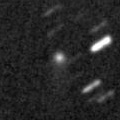
|
Now it is 16.0 mag (Feb. 16, Alexander Baransky). It stays 16 mag for a long time from 2017 to 2018.
Date(TT) R.A. (2000) Decl. Delta r Elong. m1 Best Time(A, h)
Mar. 11 8 34.64 0 35.1 4.889 5.660 137 16.5 21:17 (180, 54)
Mar. 18 8 29.97 1 54.1 4.952 5.643 129 16.5 20:45 (180, 53)
|

|
Now it is 16.2 mag (Mar. 4, T. Ikemura, H. Sato). It stays 16.5 mag from 2016 to 2017. In the Northern Hemisphere, it stays observable in good condition for a long time. In the Southern Hemisphere, it will never be observable again.
Date(TT) R.A. (2000) Decl. Delta r Elong. m1 Best Time(A, h)
Mar. 11 18 47.02 46 12.4 6.393 6.275 78 16.6 4:29 (210, -1)
Mar. 18 18 51.24 47 39.3 6.366 6.280 80 16.6 4:36 (205, 1)
|
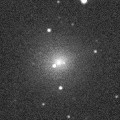
|
It brightened up to 11-12 mag in autumn. Now it is fading. It has already faded down to 16.9 mag (Mar. 3, T. Ikemura, H. Sato).
Date(TT) R.A. (2000) Decl. Delta r Elong. m1 Best Time(A, h)
Mar. 11 13 49.07 -16 21.8 1.600 2.438 138 16.7 2:35 (180, 71)
Mar. 18 13 44.12 -15 54.1 1.592 2.487 147 16.9 2:03 (180, 71)
|
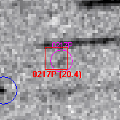
|
It will brighten rapidly, and it is expected to brighten up to 12 mag from July to September. In the Southern Hemisphere, it stays at the same altitude in the morning sky. In the Northern Hemisphere, it will be getting higher slowly.
Date(TT) R.A. (2000) Decl. Delta r Elong. m1 Best Time(A, h)
Mar. 11 20 39.50 -15 22.5 2.575 1.957 42 17.0 4:29 (274, 22)
Mar. 18 20 57.28 -14 36.5 2.472 1.900 44 16.8 4:36 (271, 25)
|
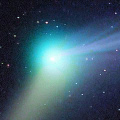
|
It brightened up to 6 mag from autumn in 2015 to early 2016. Now it is fading. It has already faded down to 17.1 mag (Feb. 28, Yasukazu Ikari). It is observable in good condition in the Northern Hemisphere. It is not observable after this in the Southern Hemisphere.
Date(TT) R.A. (2000) Decl. Delta r Elong. m1 Best Time(A, h)
Mar. 11 2 59.93 44 13.6 6.345 6.043 67 16.8 19:49 (141, -7)
Mar. 18 3 2.67 43 53.4 6.510 6.107 62 16.9 19:38 (139, -8)
|

|
It has not been observed since last April. Now it is fading. But it must be bright as 17 mag still now.
Date(TT) R.A. (2000) Decl. Delta r Elong. m1 Best Time(A, h)
Mar. 11 17 6.10 -19 55.8 2.715 2.940 93 16.9 4:29 (236, 66)
Mar. 18 17 8.79 -19 36.0 2.685 3.012 99 16.9 4:36 (219, 71)
|
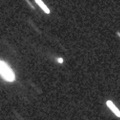
|
Now it is 16.5 mag (Feb. 23, T. Ikemura, H. Sato). It brightened rapidly, and became brighter than originally expected. It stays 17 mag until 2017. In the Northern Hemisphere, it stays observable in excellent condition for a long time. It is not observable in the Southern Hemisphere.
Date(TT) R.A. (2000) Decl. Delta r Elong. m1 Best Time(A, h)
Mar. 11 12 47.98 61 26.9 6.853 7.403 120 17.0 1:34 (180, -6)
Mar. 18 12 37.59 61 31.0 6.880 7.412 118 17.0 0:57 (180, -6)
|
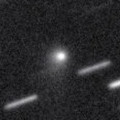
|
It brightened up to 15 mag in early 2016. Now it is fading. It has already faded down to 17.1 mag (Mar. 3, K. Hills). In the Northern Hemisphere, it stays observable in good condition for a long time until autumn when the comet will be fainter than 18 mag. It will never be observable after this in the Southern Hemisphere.
Date(TT) R.A. (2000) Decl. Delta r Elong. m1 Best Time(A, h)
Mar. 11 15 25.67 71 21.4 6.168 6.461 102 17.1 4:11 (180,-16)
Mar. 18 15 18.74 71 45.1 6.209 6.491 102 17.1 3:36 (180,-17)
|
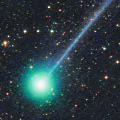
|
It brightened rapidly up to 6.8 mag (Jan. 6, Katsumi Yoshimoto). It approached to the sun down to 0.3 a.u. on Jan. 14. Michael Mattiazzo reported that the comet was visible in the SWAN images from Jan. 19 to Feb. 6 while it faded from 5 mag to 12 mag. It is not observable after this in the Northern Hemisphere. In the Southern Hemisphere, it is observable in the extremely low sky in the evening. But it is not detected, fainter than 15 mag (Feb. 24, Michael Mattiazzo).
Date(TT) R.A. (2000) Decl. Delta r Elong. m1 Best Time(A, h)
Mar. 11 0 12.95 -27 0.8 2.184 1.362 25 17.2 19:49 ( 61, 6)
Mar. 18 0 32.94 -25 22.2 2.312 1.488 26 17.9 19:38 ( 63, 5)
|
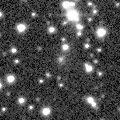
|
It will pass the perihelion in 2019. However, it has not been brightening since the discovery in 2010. Now it is 17.4 mag (Feb. 28, T. Ikemura, H. Sato). It stays observable in excellent condition in the Northern Hemisphere. It is not observable in the Southern Hemisphere.
Date(TT) R.A. (2000) Decl. Delta r Elong. m1 Best Time(A, h)
Mar. 11 3 48.86 60 2.7 9.527 9.435 81 17.3 19:49 (157,-13)
Mar. 18 3 52.12 59 56.5 9.597 9.417 76 17.3 19:38 (156,-14)
|
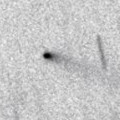
|
Now it is 17.0 mag (Feb. 16, Alexander Baransky). It was observed at 17 mag last winter. It will be observable at 17 mag again next winter. It is observable in good condition in the Northern Hemisphere. But it locates low in the Southern Hemisphere.
Date(TT) R.A. (2000) Decl. Delta r Elong. m1 Best Time(A, h)
Mar. 11 11 8.86 39 13.5 3.337 4.185 144 17.3 23:51 (180, 16)
Mar. 18 11 5.14 40 18.8 3.408 4.214 139 17.4 23:20 (180, 15)
|
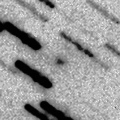
|
Now it is 17.8 mag (Feb. 28, T. Ikemura, H. Sato). In the Northern Hemisphere, it is observable at 17-18 mag until March. It is not observable in the Southern Hemisphere.
Date(TT) R.A. (2000) Decl. Delta r Elong. m1 Best Time(A, h)
Mar. 11 15 27.95 82 52.2 1.729 2.100 97 17.4 4:16 (180,-28)
Mar. 18 12 12.74 82 44.5 1.753 2.136 98 17.5 0:40 (180,-28)
|

|
Now it is 17.9 mag (Mar. 3, T. Ikemura, H. Sato). It stays observable in good condition for a while, but it will be fainter than 18 mag in April.
Date(TT) R.A. (2000) Decl. Delta r Elong. m1 Best Time(A, h)
Mar. 11 12 38.35 2 56.9 1.821 2.781 161 17.5 1:25 (180, 52)
Mar. 18 12 33.31 3 51.4 1.828 2.812 168 17.6 0:52 (180, 51)
|
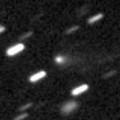
|
Now it is 15.8 mag (Feb. 25, Alexander Baransky). It is observable in excellent condition in the Northern Hemisphere. It locates low in the Southern Hemisphere. It is brighter than this ephemeris recently.
Date(TT) R.A. (2000) Decl. Delta r Elong. m1 Best Time(A, h)
Mar. 11 6 46.36 32 37.0 3.051 3.506 109 17.5 19:49 (176, 22)
Mar. 18 6 49.93 32 11.6 3.156 3.518 103 17.7 19:38 (173, 22)
|
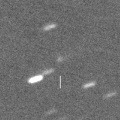
|
Now it is 17.8 mag (Feb. 3, T. Ikemura, H. Sato). It is observable at 17.5 mag in good condition from winter to spring.
Date(TT) R.A. (2000) Decl. Delta r Elong. m1 Best Time(A, h)
Mar. 11 15 10.23 -11 38.0 1.735 2.411 121 17.6 3:56 (180, 67)
Mar. 18 15 11.13 -11 42.0 1.681 2.429 128 17.6 3:29 (180, 67)
|
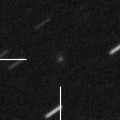
|
Now it is 18.0 mag (Feb. 28, Yasukazu Ikari). It is observable in good condition in the Southern Hemisphere.
Date(TT) R.A. (2000) Decl. Delta r Elong. m1 Best Time(A, h)
Mar. 11 5 45.72 -27 56.0 3.694 3.873 92 17.7 19:49 (107, 71)
Mar. 18 5 45.45 -25 13.1 3.775 3.879 88 17.8 19:38 (109, 67)
|

|
It brightened up to 8-9 mag from winter to spring in 2016. Now it is fading. It has already faded down to 18.9 mag (Feb. 25, T. Ikemura, H. Sato).
Date(TT) R.A. (2000) Decl. Delta r Elong. m1 Best Time(A, h)
Mar. 11 12 46.96 -16 6.0 4.305 5.200 151 17.9 1:33 (180, 71)
Mar. 18 12 41.09 -16 12.1 4.317 5.257 158 18.0 1:00 (180, 71)
|
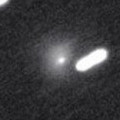
|
Very far object. Outburst occured on Feb. 20, 2015, and it brightened up to 15 mag. Now it is 17.8 mag (June 4, Space Surveillance Telescope, Atom Site). It is observable in excellent condition in the Southern Hemisphere. It locates low in the Northern Hemisphere.
Date(TT) R.A. (2000) Decl. Delta r Elong. m1 Best Time(A, h)
Mar. 11 14 43.17 -26 43.6 8.783 9.363 123 17.9 3:29 (180, 82)
Mar. 18 14 42.35 -26 40.8 8.696 9.369 130 17.9 3:01 (180, 82)
|
|
![]()
 73P/Schwassmann-Wachmann 3
73P/Schwassmann-Wachmann 3 45P/Honda-Mrkos-Pajdusakova
45P/Honda-Mrkos-Pajdusakova 103P/Hartley 2
103P/Hartley 2 C/2016 VZ18 ( PanSTARRS )
C/2016 VZ18 ( PanSTARRS ) C/2017 E1 ( Borisov )
C/2017 E1 ( Borisov ) 71P/Clark
71P/Clark 29P/Schwassmann-Wachmann 1
29P/Schwassmann-Wachmann 1 315P/2013 V6 ( LONEOS )
315P/2013 V6 ( LONEOS ) C/2016 R2 ( PanSTARRS )
C/2016 R2 ( PanSTARRS ) 65P/Gunn
65P/Gunn C/2015 O1 ( PanSTARRS )
C/2015 O1 ( PanSTARRS ) C/2015 VL62 ( Lemmon-Yeung-PanSTARRS )
C/2015 VL62 ( Lemmon-Yeung-PanSTARRS ) C/2011 KP36 ( Spacewatch )
C/2011 KP36 ( Spacewatch ) 93P/Lovas 1
93P/Lovas 1 C/2016 N4 ( MASTER )
C/2016 N4 ( MASTER ) 81P/Wild 2
81P/Wild 2 C/2014 B1 ( Schwartz )
C/2014 B1 ( Schwartz ) 213P/Van Ness
213P/Van Ness 74P/Smirnova-Chernykh
74P/Smirnova-Chernykh C/2016 B1 ( NEOWISE )
C/2016 B1 ( NEOWISE ) C/2016 M1 ( PanSTARRS )
C/2016 M1 ( PanSTARRS ) 43P/Wolf-Harrington
43P/Wolf-Harrington C/2014 W2 ( PanSTARRS )
C/2014 W2 ( PanSTARRS ) C/2016 A1 ( PanSTARRS )
C/2016 A1 ( PanSTARRS ) C/2014 OE4 ( PanSTARRS )
C/2014 OE4 ( PanSTARRS ) 144P/Kushida
144P/Kushida 217P/LINEAR
217P/LINEAR C/2013 US10 ( Catalina )
C/2013 US10 ( Catalina ) C/2015 TQ209 ( LINEAR )
C/2015 TQ209 ( LINEAR ) C/2014 R3 ( PanSTARRS )
C/2014 R3 ( PanSTARRS ) C/2013 V4 ( Catalina )
C/2013 V4 ( Catalina ) C/2016 U1 ( NEOWISE )
C/2016 U1 ( NEOWISE ) C/2010 U3 ( Boattini )
C/2010 U3 ( Boattini ) C/2015 X7 ( ATLAS )
C/2015 X7 ( ATLAS ) C/2016 T2 ( Matheny )
C/2016 T2 ( Matheny ) 118P/Shoemaker-Levy 4
118P/Shoemaker-Levy 4 P/2015 TP200 ( LINEAR )
P/2015 TP200 ( LINEAR ) 94P/Russell 4
94P/Russell 4 C/2017 A3 ( Elenin )
C/2017 A3 ( Elenin ) C/2014 S2 ( PanSTARRS )
C/2014 S2 ( PanSTARRS ) C/2013 C2 ( Tenagra )
C/2013 C2 ( Tenagra )![]()










































